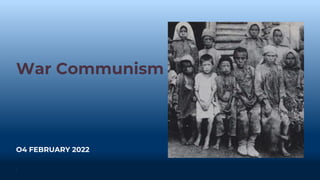
War communism History Lesson grade 11
- 1. War Communism O4 FEBRUARY 2022 1
- 2. War Communism Between 1918 and 1921 the Bolsheviks fought against their opponents in the Civil War. During this time, Lenin was responsible for leading the Bolsheviks and making sure the Red Army were well supplied in order to win the war. Lenin faced a difficult task as the Russian economy had already been damaged during the First World War. In the spring of 1918, people began to riot in several Russian cities as they needed food and basic necessities to survive. To overcome these issues and to keep the Red Army supplied, Lenin introduced a dramatic economic policy called War Communism. 2
- 3. Effects of War Communism 3
- 4. Agriculture Lenin needed to feed the workers in the cities and the soldiers in the Red Army. To do this, food rationing was introduced and people had to survive off very little food each day. To produce more bread for the workers, Lenin forced peasants in the countryside to give up their grain for free. This was known as grain requisitioning. When peasants refused to give up their grain, they were punished harshly by the Cheka, who arrested thousands of peasants and forced them into labour camps. To resist the Bolsheviks, many peasants began to produce less grain as they knew it was likely to be taken away by the Bolsheviks. The policy of grain requisitioning caused Russian agriculture to collapse and in 1921, Russia experienced a famine that caused the death of 5 million people. 4
- 5. Industry Whilst War Communism was partly introduced to help the Bolsheviks win the Civil War, it was also introduced to spread communism in Russia. One of the Bolsheviks’ communist beliefs was that the state should control industry instead of private owners. Therefore during the Civil War, the government took control of industry and controlled what factories produced. Lenin put managers in place who supported the Bolsheviks and used strict discipline to control the workers. The Bolsheviks also made it illegal for traders to buy and sell goods. These policies were not successful and by 1921, the amount of goods produced in factories had decreased. Money had become almost worthless and many people resorted to illegal activities such as stealing food to survive. 5
- 6. The Kronstadt Uprising By the end of the Civil War in 1921 the Russian economy was devastated. War Communism had contributed to the Red Army winning the Civil War. But War Communism had also caused the deaths of millions and increased opposition towards the Bolsheviks. One example of opposition to the Bolsheviks was the Kronstadt Rebellion in March 1921. This was an uprising of sailors in a naval base outside of Petrograd. Although sailors had previously supported the Bolsheviks, the sailors staged an uprising in response to War Communism and the impact it had on the Russian economy. To suppress this uprising, the Bolsheviks used the Red Army to attack the sailors and as a result hundreds of men were killed or wounded. Although the Bolsheviks successfully crushed the Kronstadt Uprising, it showed that the Bolsheviks were losing their support from the Russian population. 6
- 7. The New Economic Policy Following the Kronstadt Uprising, Lenin introduced the New Economic Policy (NEP). He hoped that this would improve the Russian economy and overcome some of the problems caused by War Communism during the Civil War. This policy went back on some of the communist policies introduced during War Communism. Many Bolsheviks were angry as they did not wish to reverse these policies and feared that the NEP signalled a return to economic policies under the Tsar. However, Lenin believed it was essential for the Bolsheviks to improve the economy to prevent further uprisings and to maintain power. He believed that once the economy had been strengthened, the Bolsheviks could continue to introduce more communist policies. 7
- 8. The New Economic Policy During the NEP, the Bolsheviks returned the control of smaller factories to their owners, although the government did keep control of large industries such as steel and coal. The Bolsheviks also allowed traders to buy and sell goods, something that had been illegal during War Communism. Grain requisitioning also stopped and instead peasants had to give a certain amount of grain to the government each year and could keep any surplus produce. As a result, the Russian economy improved and some workers and peasants became more wealthy. Foreign countries also began to trade with Russia, showing that the economy had partly recovered. 8
- 9. What did these policies reveal about the Bolsheviks? War Communism and the New Economic Policy demonstrated that the Bolsheviks were willing to change their policies to hold onto power. Although War Communism had been introduced to win the Civil War, it was also used to spread communism in Russia. Despite this, the Bolsheviks were willing to reverse the policy of War Communism to hold onto power in the 1920s. Although the New Economic Policy angered many Bolsheviks as they saw it as a return to capitalism, it was viewed as essential for holding onto power. 9
- 10. Comprehension questions 1. During which event did the Bolsheviks introduce War Communism? 2. Describe one method used by the Bolsheviks to feed workers and soldiers. 3. Why did Lenin introduce the New Economic Policy? 4. What impact did the New Economic Policy have on the economy? 5. Challenge question - Why were some Bolsheviks angered by the New Economic Policy? 10
